How to Read Violin Sheet Music (easy guide for beginner violinists)
Beginner guide to reading sheet music for the violin
Learn how to read which note and finger to play and in which rhythm
Do you have a strong desire to learn the violin, but have never read music before in your life?
The prospect of learning music notation should not be a paralyzing fear that keeps you from following your musical dreams. By learning a few basics and practicing patience, you can learn to read music fluently while still enjoying your music-making.
The first step is making sure you understand what all the shapes and symbols on the page refer to. If the composer bothered putting it down, it’s probably important! To demonstrate this, let’s look at a simple example where I’ve highlighted all the different types of markings:
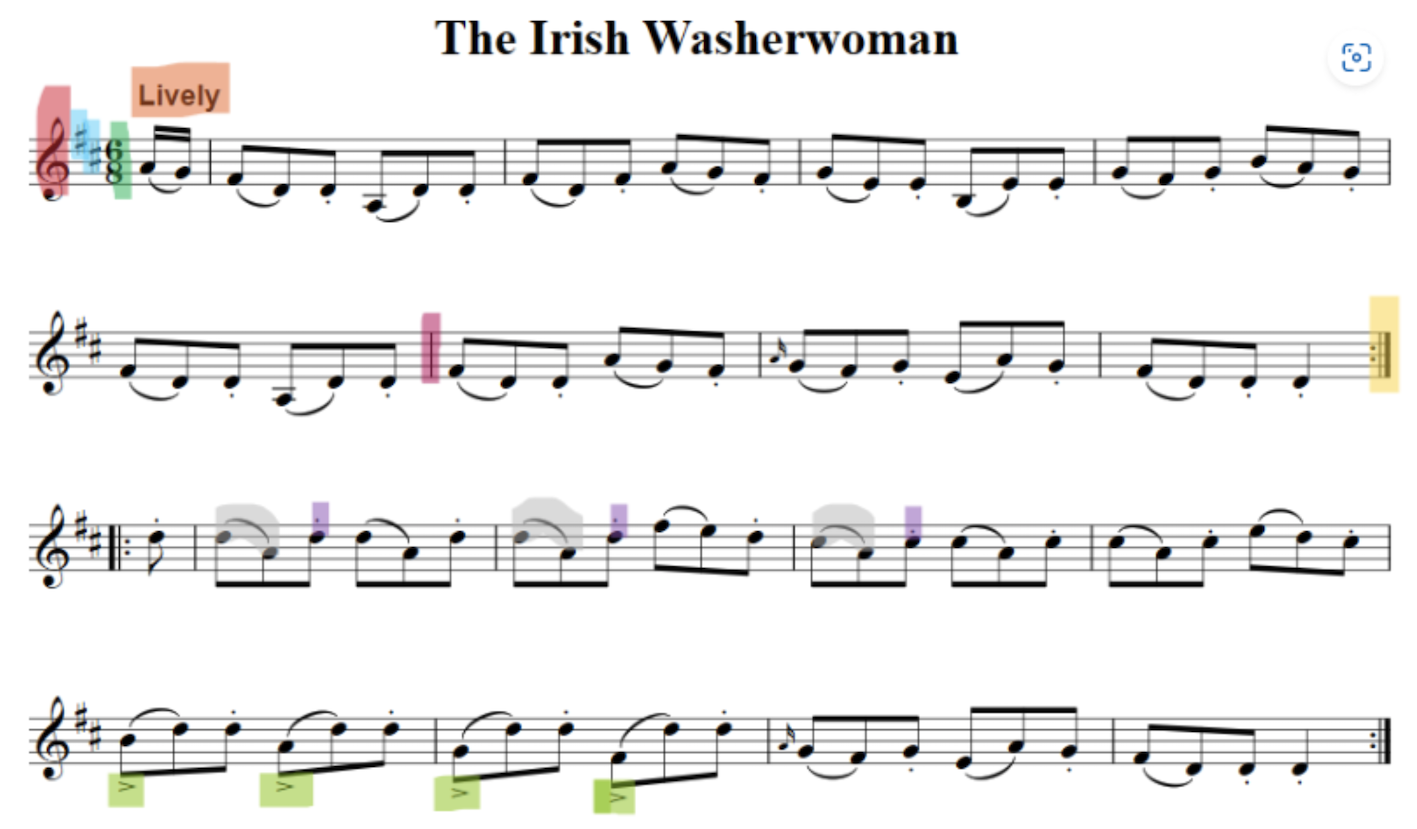
Orange: Composers often put a simple word or phrase in the top left-hand corner to describe the emotion feeling the piece should have, in this case “Lively”. Often there will also be a specific tempo marking in this corner.
Red: The treble clef sign appears at the beginning of every line of violin music. Treble clef tells you which line the note G is on. All violin music is written only in this clef (sorry violists!).
Blue: The key signature consists of either sharps or flats (never both). If the piece is in C Major or A Minor, there will be nothing marked in the key signature. Don’t worry, this will make more sense when we discuss keys and accidentals further down. Knowing your key signatures is very important for putting your fingers in the right place.
Pink: Measure lines divide music into equally-sized boxes, making it easier to read and count.
Green: The time signature shows how many beats are in each measure. The top number shows how many beats there are, and the bottom number shows what type of note (half, quarter, eighth, etc.) gets the beat. We will discuss this more in the section on rhythms. In more advanced sheet music, the time signature (and/or key signature) may change in the middle of the piece.
Yellow: A double bar line with two dots is a repeat sign, meaning to play the preceding section over again. In the second half of this piece, you can see repeat signs at the beginning of the third line and the end of the fourth line, indicating the exact section to be repeated.
Grey, Purple, Lime Green: Any other special markings you see on the page are technique markings. In this case, there are slurs, staccato marks, and accent marks. Advanced pieces, such as the Sibelius violin concerto, have tons of very specific technique marks! Always look up ones you aren’t familiar with.
Now that we’ve been through the basics of what you’ll see in music, let’s get to the fun part: reading notes!
Reading Notes in Violin Music
The first notes you will learn on violin are the open strings: G, D, A, E.
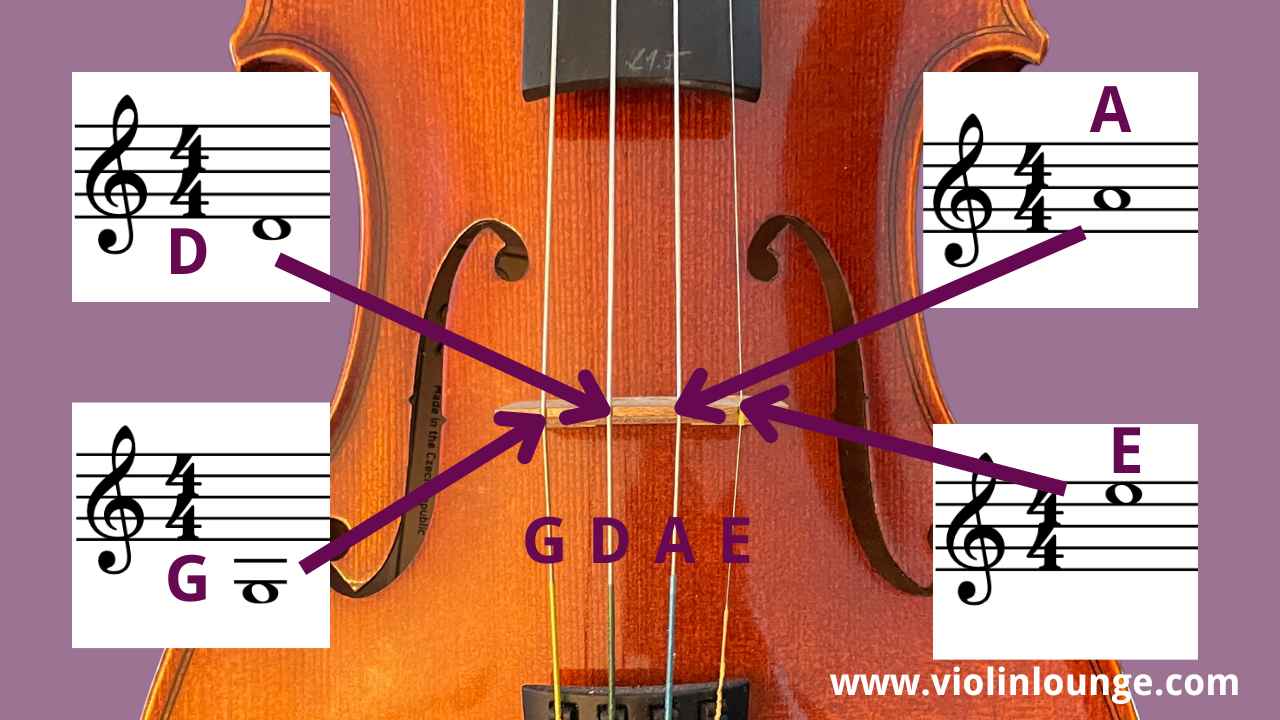
Below is how the open strings sound, so you can recognize them. Always make sure your violin is tuned. You can use my free online violin tuner with microphone and tuning notes for that.
Now before we jump in to reading all the notes in first position, let’s go over some key signatures. Sharps # raise the note a half step, flats b lower the note a half step. Every piece of classical music has a key signature, and every key signature goes with its own major and minor scales. The most common beginner violin scales are A Major, D Major, G Major, and C Major. If you want to get in some practice on these scales, check out the article Violin Scales: Learn the Most Common Scales on Violin.
If you have tapes on your violin, those tapes correspond to these notes (from low to high):
Open G A B C D
Open D E F# G A
Open A B C# D E
Open E F# G# A B
If your violin does not have tapes, watch this clip to see how the fingers are placed:
Every finger, but especially the second finger, can be placed on the fingerboard in “low” or “high” position. Just remember that this does NOT always correspond to sharp and flat. Playing a series of half steps is called chromaticism. Check out this clip to see how the fingers move from low to high and the corresponding notes:
Now that you are comfortable with reading the notes of first position (you’ve been practicing those scales, right?) It is time to see how they fit together in pieces. This is where rhythm becomes very important. Rhythm is how long or short notes are in relation to each other. So what does that mean?
How to Read Time Signatures
Measures of music are divided into beats. The beat stays steady, even if the rhythm is changing over it. Beat and rhythm are not the same thing! The beat of the music is more formally called the meter. There are two types: simple meter and compound meter. Simple meter is when the beats divide into twos, and compound meter is when the beats divide into threes. 2/4 and 4/4, and 3/4 are all examples of simple time, while 6/8 and 6/4 are examples of compound meter.
Let’s quickly review how to read time signatures
Time signatures are made up of two numbers. The top number indicates how many beats are in each measure and the bottom number indicates which note is equivalent to a beat. For example, in the time signature ¾, the top number 3 tells us there are 3 beats in the measure, and the bottom number 4 tells us the quarter note gets the beat. If you were to see a 2 on the bottom, that indicates the half note gets the beat, an 8 indicates that the eighth note gets the beat, and a 16 indicates that the sixteenth note gets the beat. You can think of the beat as one metronome click.
The standard rhythm is 4/4. If you see a big “C” in front of the music where the measure usually is, the measure is 4/4. A waltz is usually a 3/4 measure. A tango is often a 2/4 measure.
Rhythms let us know when a note should be played and how long a note should be held for. Here are some of the most common rhythms and how many beats they get in a 4/4 measure.
A whole note gets four beats
A half note gets two beats
A quarter note gets one beat
An eighth note gets half a beat (two eighth notes equal one beat)
A sixteenth note gets one-quarter of a beat (four sixteenth notes equal one beat)
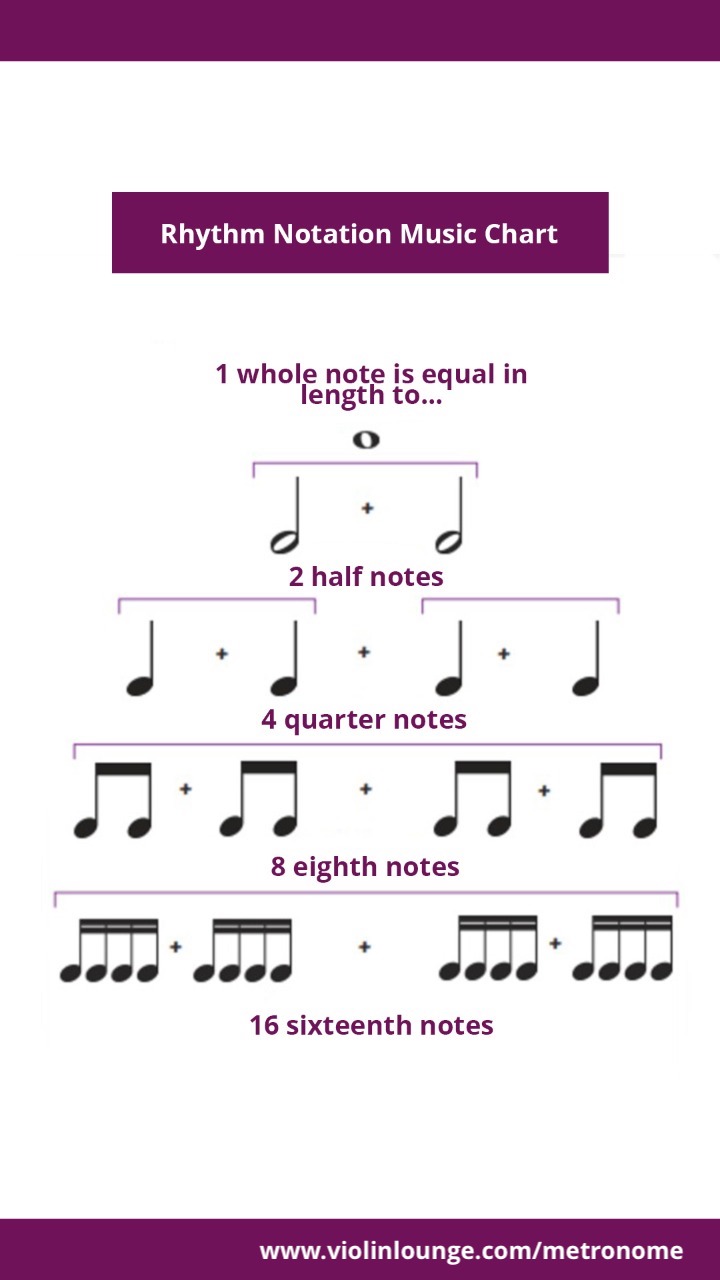
Dotted Rhythms
Whenever you see a dot next to a note (directly next to it, not under or over it as that means something else entirely), it tells us to add half of that note’s value to that note. Let’s use a dotted half note as an example. A half note gets two beats- half of two is one, so I add one beat to the note getting a total duration of three beats.
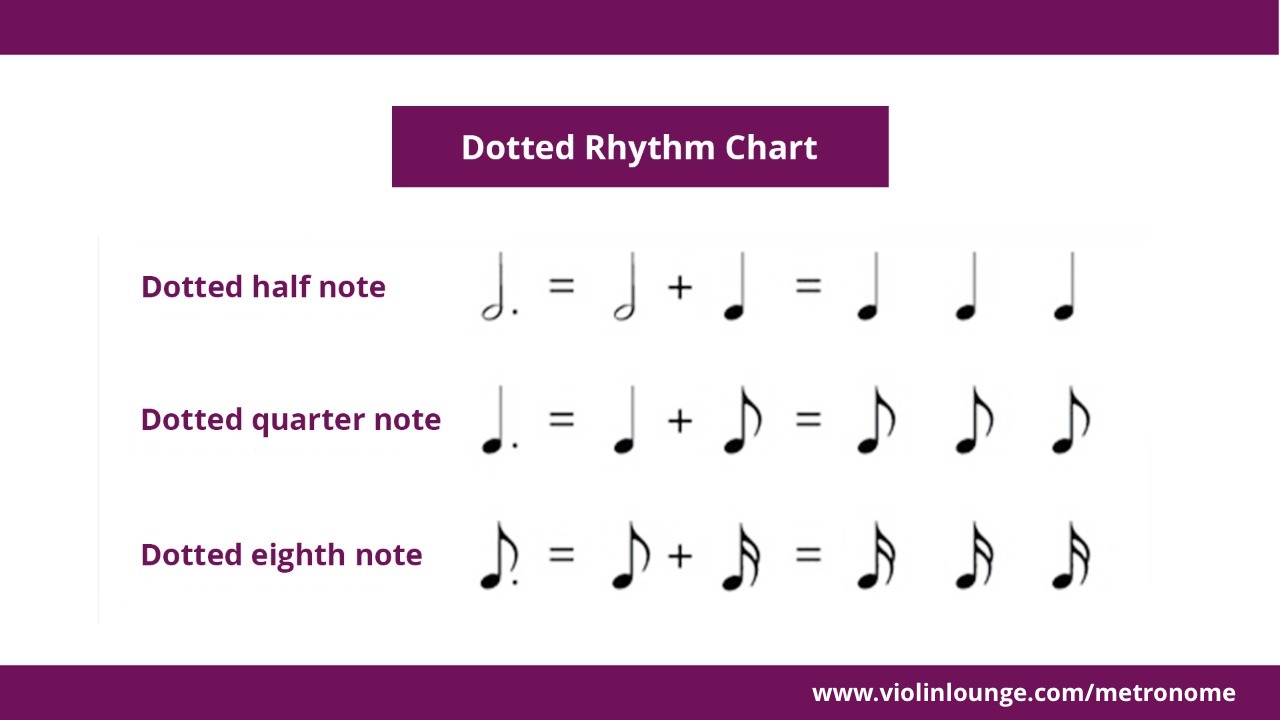
Reading Rests in Violin Sheet Music
For every note value, there is also a rest of the same length. Rests can also be combined into different lengths by using dots. Here is a chart of all the symbols for notes and rests:
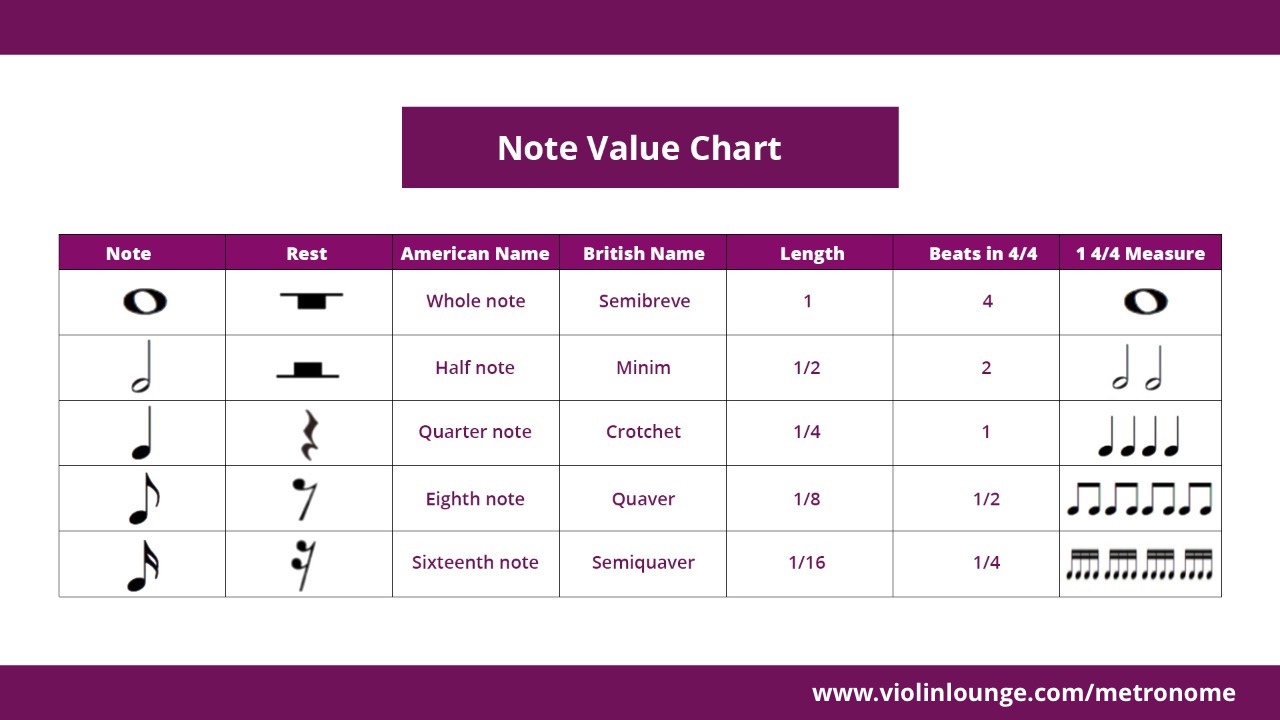
How to know how fast you should play?
We’ve covered a lot around rhythm, but you might have noticed that this covers how fast the notes are in relation to another. We haven’t covered how to know in which tempo, how many beat per minute (BPM) a quarter note should be for example. That’s because there’s no fixed BPM for a quarter note or any other note value. It’s indicated by tempo markings. You can find a list of the most common tempo markings and their corresponding BPM right here.
Other symbols: Dynamics, Technique Markings, Etc.
We will talk a little bit about the other “stuff” you see on violin music, because when there’s a lot of it it can be overwhelming!
Dynamic Markings
Dynamic markings show how loud or soft to play a passage. Dynamics come from italian words: piano means “soft”, mezzo means “medium”, and forte means “strong”. To make something even softer or louder, you add more of the same letter. The dynamics in order of softest to loudest are ppp, pp, p, mp, mf, f, ff, fff, and (very occasionally) ffff. (Is it just me, or should there be an mmm dynamic?)
Composers also use words like crescendo or diminuendo to indicate changes in dynamic level. “Hairpins” like this are also used.
Technique Markings
Technique markings can be either symbols or words. They might also be in french, italian, or german! Symbols you’ll see include slurs, staccato dots (over or under the notes) accents, fermatas, trills, codas and repeat signs. I invite you to do a little more research into this as you feel moved. As for words, composers put all kinds of things in music these days! It is best to look it up on a case by case basis if you’ve never seen it before. It is tempting to ignore things written into the part, but that is what brings life to the notes.
Now that you have a basic idea of what everything on your sheet music means, don’t hesitate to open up your next piece! The only real way to learn music reading is by doing it consistently. Even if it is slow at first, through repetition and dedication you will grow more and more fluent.
Join my FREE beginner violin course
I take you from scratch step by step to your first violin concerto including 40 videos, sheet music and violin tabs.

Hi! I'm Zlata
Classical violinist helping you overcome technical struggles and play with feeling by improving your bow technique.
BONUS: How to Read Violin Notes in High Positions
If you have already mastered reading notes in first position and want a challenge, it is time to move on to the higher positions! Shifting is an essay in itself, so here we will simply talk about how to read all those crazy leger lines that you see in super high violin melodies. For example, here’s an excerpt from the Tchaikovsky Concerto:
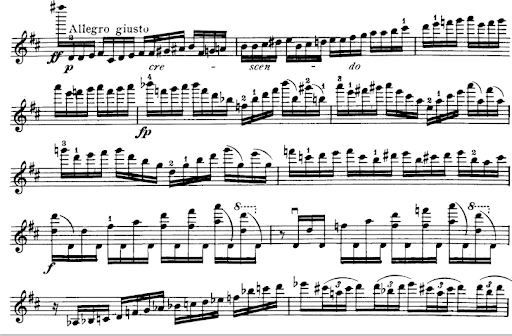
Aside from the fact these are all sixteenth notes, how do you even know what notes those are!? Advanced violin music frequently incorporates leger lines to play notes far above the staff. The challenge is remembering which note goes where! Just remember the pattern is the same. The very top line of the treble clef staff is an F, so the next note is a G and the first leger line is an A, etc.
Often you will have to quickly figure out what a note is by counting the leger lines. It is very important to memorize the notes on the leger lines in the right order. This is A, C, E, G, B, etc. Sometimes composers make this easier by using an 8va sign (see fourth line of Tchaikovsky). There’s fewer leger lines so it’s easier to read the note, but it’s actually an octave higher than that!
Learning to read music fluently takes time, but it is possible for everyone. If the sheet music looks overwhelming just take it slow, look up symbols, and learn one step at a time.

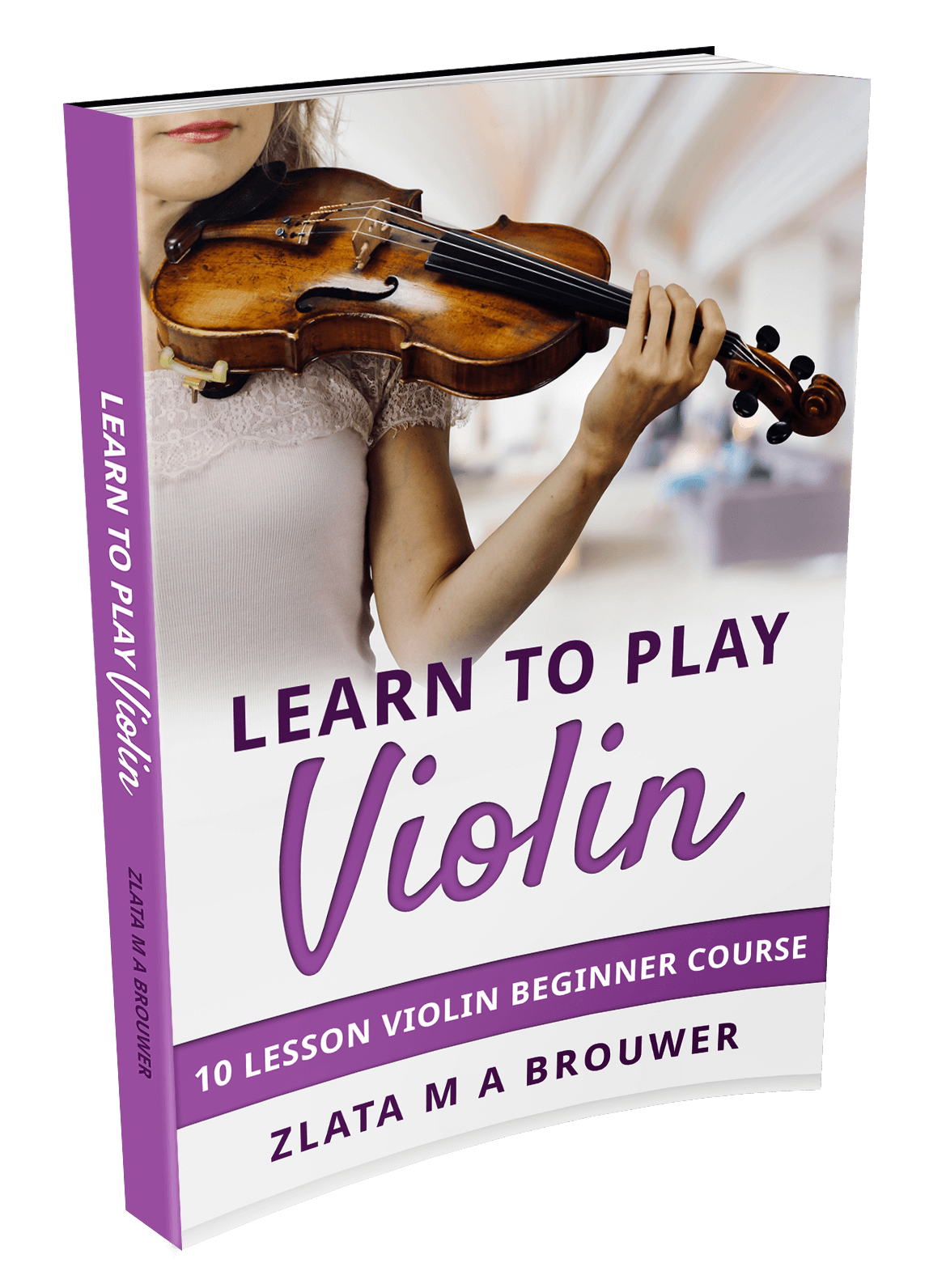
After attempting to play for about 18 months, after reading this, I realise that there a quite a few things that I do not know. For example: the rests and the “ppp” etc. Fortunately, with your recommendation, I use Tomplay. So, I always listen to piece before I start trying to play it. Then, I try playing along with Tomplay. However, it’s really nice to know what all this stuff means.
Many thanks for this Zlata. Very useful.
Best wishes, Peter.
Wonderful, Peter!
????????????
After playing for 2 months, I relised that violin is something easy to learn, it just need more practice, it also need a violin daily routin, if we want to play violin we need to be more patient, you have to listen carefully and try your best. thanks Ms.Zalata. Very marvellous.
Best wishes, Student Rancy
My daughter has nearly finished the first Suzuki Method violin book. There are some notes in one of the upcoming pieces that she doesn’t know what they mean. It looks like eighth notes but in the middle of the stem is an angled bar. We can find a notation in the book that would explain this and her next lesson.